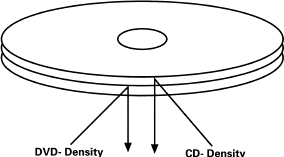Comparison with CD
While the surface area of a single DVD layer is the same as that of a CD, technical advances in both optical media and digital processing algorithms give the DVD layer more than seven times greater data capacity. This greater capacity is achieved in part by reducing the size of the ‘pits’ used to mark the data on the disc surface, so that more pits fit in a given area. Increased pit density means more available bits. And with a more efficient error correction scheme, DVD needs to reserve fewer bits for data redundancy, allowing more overall material to be stored on the disc.
Table 2.1 Media specifications of the DVD and CD systems.
DVD |
CD |
|
Disc diameter |
120 mm (5 in.) |
120 mm (5 in.) |
Disc thickness |
1.2 mm (2 bonded 0.6-mm layers) |
1.2 mm |
Track pitch |
0.74 pm |
1.6 pm |
Laser wavelength |
650 or 635 nm red laser |
780 nm red laser |
Numerical aperture |
0.60 |
0.45 |
Minimum pit length |
0.4 pm |
0.83 pm |
Error correction |
RS-PC |
CIRC |
Signal modulation |
B-16 (EFM+) |
B-14 (EFM) |
Reference scanning velocity |
3.49 m/s (single layer) |
1.2 to 1.4 m/s |
Data capacity |
4.7 to 17 Gigabytes |
650 Megabytes |
Maximum data rate |
10.00 Mbps |
1.4112 Mbps |
We refer above to DVD ‘layers’ because the physical construction of a DVD is quite different from that of a CD. While a CD is always a single piece of moulded polycarbonate, DVD can be manufactured in at least four different physical variations, each with a different data capacity. All of these variations are made up of two polycarbonate platters (substrates) bonded back-to-back. The finished thickness of these discs is the same as that of a CD, but the double-sided manufacturing technique increases the rigidity of the media and minimizes warpage.

Figure 2.1 Physical structure of a DVD disc.
DVD’s disc configurations are referred to by their capacities in Gigabytes (GB), rounded (for the sake of convenience) up to the next whole number. In the world of computers, a Gigabyte would mean a million kilobytes of 1024 bytes each. However, in the case of DVD, data capacity and data rate are measured in simple multiples. For example, a kilobyte equals 1000 bytes (not 1024 bytes), a megabit equals 1 000 000 bits, and 1 GB means one billion bytes.
Table 2.2 Capacity of DVD disc configurations.
DVD size |
Number of sides |
Number of layers per side |
Capacity (billion bytes) |
DVD-5 |
1 |
single |
4.70 |
DVD-9 |
1 |
dual |
8.54 |
DVD-10 |
2 |
single |
9.40 |
DVD-18 |
2 |
dual |
17.08 |
As shown in Table 2.2, the base-case DVD – a single-sided/single-layer disc – has a capacity of 4.7 GB, and is called a DVD-5. For DVD-Video titles requiring greater capacity, several other configurations are currently in use. DVD-9 discs (single-sided/dual layer) allow direct access to all the data stored on both layers, while DVD-10s (double-sided/single-layer) are two discrete discs, requiring that the DVD be turned over to access information on the other side. The largest capacity discs are DVD-18s (double-sided/double-layer), which are effectively two discrete DVD-9 discs in one. And at least one replicator, Warner Advanced Media Operations, is also offering a DVD-14 configuration (dual layer on one side, single layer on the other) which was not anticipated in the DVD specification.
Mixed-density dual-layer discs
One of the requirements originally considered for DVD-Audio was that discs in the new format be playable on existing CD players. A frequent topic of discussion in ISC/WG-4 meetings was the possibility of achieving this with a mixed density disc. Based on the dual-layer technology developed for DVD, these discs would combine a conventional CD layer with a semitransparent layer containing high-density DVD information. The idea was that the disc would play from the CD layer if placed in a conventional CD-Audio player, while playing the DVD-Audio program when played in a DVD-Audio player.
To date, no one has announced any plans to manufacture or release a product combining a CD layer and a DVD-Audio layer into one disc. One complicating factor is that the charter of Working Group-4 did not extend to specifying player capabilities (which is the province of another working group). Another problem is that, at least at the present time, the cost to manufacture a mixed density disc is significantly greater than the cost of manufacturing a single layer DVD disc, and this cost in turn is quite a bit greater than the cost of manufacturing a conventional CD.

Figure 2.2 Physical structure of a mixed-density DVD disc.
While it is certain that manufacturing costs for DVD disc replication and dual-layer replication will fall, it is unlikely that these will approach the cost of conventional CD manufacturing for quite some time. That makes it unlikely that a mixed-density disc with a CD layer will be incorporated into DVD-Audio anytime in the near future.
